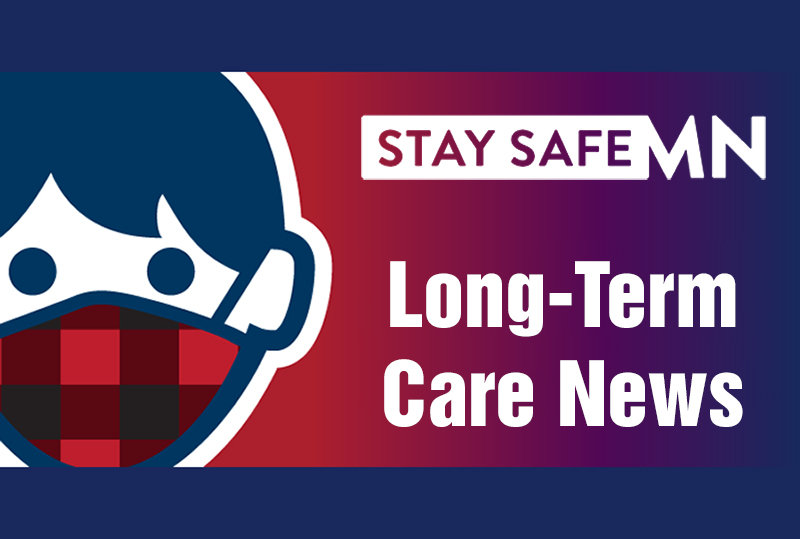Support the Timberjay by making a donation.
Inside access to long-term care sites for "essential caregivers" coming
Sites weigh options with eye toward safety first
REGIONAL- For the first time since long-term care facilities were locked down four months ago to combat the spread of COVID-19, Gov. Tim Walz, on Friday, announced a path for residents to begin …
This item is available in full to subscribers.
Attention subscribers
To continue reading, you will need to either log in to your subscriber account, or purchase a new subscription.
If you are a current print subscriber, you can set up a free website account and connect your subscription to it by clicking here.
If you are a digital subscriber with an active, online-only subscription then you already have an account here. Just reset your password if you've not yet logged in to your account on this new site.
Otherwise, click here to view your options for subscribing.
Please log in to continue |
Inside access to long-term care sites for "essential caregivers" coming
Sites weigh options with eye toward safety first
REGIONAL- For the first time since long-term care facilities were locked down four months ago to combat the spread of COVID-19, Gov. Tim Walz, on Friday, announced a path for residents to begin receiving family and others inside those facilities. Still, it’s an option individual facilities will choose based on careful planning and risk assessment.
The Minnesota Department of Health released new guidance for designating family members or others to serve as “essential caregivers” for residents of nursing homes and other assisted living facilities. People designated as essential caregivers will have expanded access to help ensure that the residents’ full range of emotional, social and physical needs are met.
Like most facility administrators, Kasey Kiefler, RN regional operations manager for Carefree Living facilities in Cook, Orr, Babbitt, Silver Bay, and Ely, was scrambling Tuesday to catch up with the guidance and emails to begin to get a handle on what they will have to do to prepare for indoor visits.
“I have yet to read the full disclosure,” Kiefler said. “It’s definitely encouraging. We’re going to have to re-do our policies. I want to be super cautious that we do it the right way.”
Kiefler said the hardest part of the lockdown has been the stress and anxiety created by isolation of residents from their families and friends. Outdoor and window visits have provided some welcome relief.
“It’s definitely improved the mental health of people,” she said. “It’s challenging because all they want to do is give each other hugs, and we have to be present to discourage that because the Minnesota Department of Health said they’re not allowed, but it has been kind of a weight lifted off my shoulders.”
It was too soon for Kiefler to speculate about when indoor visits might be made available. Facilities have to develop a comprehensive plan for how they will implement the guidelines. Still, it’s a step in the right direction.
“They’re wanting to get to the point they can actually hold their loved ones, and I’m optimistic we’re going to get there,” Kiefler said.
Cook Care Center Assistant Administrator Julie Lesemann said that her facility is planning to stick with outdoor and window visits for now.
“We watch the COVID numbers every day,” Lesemann said. “Right now, because of the positive cases that are rising, we’re going to hold on this. We’re not going to go down that road yet. We’ll probably give it another few weeks to see where it’s at.”
Lesemann noted that one factor in their decision is the influx of summer vacationers and tourists to the area, which could increase the potential for the novel coronavirus to be transmitted.
“We want to do everything we can to get our essential caregivers back with our loved ones,” she said. “It’s baby steps.”
Lesemann said the Centers for Medicare & Medicaid Services has already come up with a three-stage plan for facilities to follow once they’re cleared to re-open, and that they’re acting in accord with that plan.
“You’ve got to look at your communities, you have to look at what’s going on around you,” she said.
Meanwhile, residents, staff, and families are taking full advantage of outdoor visiting opportunities.
“It’s nonstop during the day, and that’s a good thing,” Lesemann said. “Families and the residents and the staff are absolutely loving it.”
New guidelines
Providers must talk to residents about their wishes to determine whom to designate as an essential caregiver, and facilities should establish policies for identifying and using essential caregivers no later than July 25, 2020.
An essential caregiver could be a family member, outside caregiver, friend or volunteer who has provided regular care and support to the resident before or during the pandemic. Residents can have more than one essential caregiver for providing emotional support and individualized, person-centered care.
The guidelines require caregivers to sign in and be screened prior to entering the building, just like facility staff. Caregivers must frequently wash their hands and use hand sanitizer and wear all necessary personal protective equipment while in the building (minimally, eye protection and face mask). Facilities may restrict or revoke caregiver status if the caregiver fails to follow infection prevention rules. However, facilities are expected to talk to caregivers and attempt to address concerns before restricting or revoking visitations.
MDH developed the guidance in partnership with stakeholders including Care Providers of Minnesota, LeadingAge Minnesota, the Office of Ombudsman for Long- Term Care and other consumer advocate groups.






